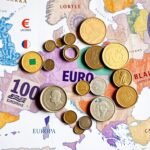
The Convertible Mark (KM) is Bosnia and Herzegovina's official currency, established through the Dayton Agreement to stabilize the post-war economy. You'll find it pegged to the euro at a fixed rate, managed by a robust currency board that prevents excessive money printing. The KM reflects the nation's complex financial journey, evolving from Ottoman and Yugoslav monetary systems to a modern, stable currency. Its banknotes showcase national identity, while its economic strategy focuses on attracting foreign investment and maintaining low inflation. The currency's resilience offers a window into Bosnia's economic transformation and potential future challenges.
Key Takeaways
- The Convertible Mark (KM) is Bosnia and Herzegovina's official currency, established in 1998 following the Dayton Agreement to stabilize the post-war economy.
- Pegged to the euro at a fixed exchange rate of 1.96 KM, the currency maintains economic stability and attracts foreign investment through its predictable monetary policy.
- Banknotes and coins feature national landmarks, historical figures, and geographic representations, symbolizing Bosnia and Herzegovina's cultural identity and economic sovereignty.
- The currency is managed by a strict currency board mechanism that prevents excessive money printing and ensures monetary discipline, maintaining low inflation rates.
- Despite challenges like political instability and potential EU integration, the Convertible Mark remains a critical tool for economic development and financial management.
Historical Journey of Bosnian Currency
Tracing the intricate monetary evolution of Bosnia and Herzegovina reveals a complex narrative of political transformations and economic adaptations. From the Ottoman Empire's gold and silver coins to the Austro-Hungarian Krone, you'll see how currency reflects shifting regional powers.
During Yugoslavia's existence, you witnessed the Yugoslav Dinar dominating financial transactions, with dramatic shifts during World War II and the subsequent socialist period.
The currency changes became most dramatic during the Bosnian War, when multiple currencies emerged along ethnic lines. You'd observe hyperinflation pushing economic instability, ultimately leading to the introduction of the convertible mark through the Dayton Agreement.
These monetary changes weren't just financial changes but profound reflections of Bosnia and Herzegovina's tumultuous political landscape, demonstrating how currency embodies a nation's complex historical journey. The Bosnian dinar's fragmentation during the conflict highlighted the deep ethnic divisions that disrupted the country's economic stability.
Design and Monetary Characteristics
Since the introduction of the Convertible Mark, Bosnia and Herzegovina's currency has embodied a sophisticated visual narrative that transcends mere monetary function. The banknote design celebrates national identity through portraits of historical figures and iconic landmarks, while coin features showcase the country's geographic essence. Currency Board mechanism ensures strict monetary discipline and prevents uncontrolled money printing.
| Denomination | Banknote Highlights | Coin Details |
|---|---|---|
| 10-200 KM | Historical portraits | 5-50 fenings |
| Cultural motifs | Landmarks | National map |
| Anti-counterfeiting | Heritage representation | Currency name |
Pegged to the euro at 1.96 KM, the currency maintains stability through a Currency Board Arrangement. The Central Bank ascertains each Convertible Mark is backed by foreign currency reserves, providing confidence in the monetary system. This approach guarantees a secure, visually compelling currency that reflects Bosnia and Herzegovina's rich cultural tapestry.
Economic Impact and Significance

The Convertible Mark (KM) stands as a pivotal economic instrument, transforming Bosnia and Herzegovina's monetary landscape through its strategic design and implementation.
You'll find that its currency stability, pegged to the euro, has been essential in attracting foreign direct investment and maintaining low inflation rates.
By facilitating trade and reducing transaction costs, the KM has simplified economic interactions both domestically and internationally.
You'll notice how this stability has enhanced the country's reputation, making it an attractive destination for investors.
The currency's credibility has directly contributed to steady GDP growth, averaging 2.7% annually, and supported key sectors like tourism and information technology.
Despite ongoing challenges like high unemployment, the Convertible Mark remains a fundamental tool in Bosnia and Herzegovina's economic development strategy. The currency maintains its peg through a carefully managed monetary policy that ensures economic resilience against external shocks.
Central Bank's Crucial Role
At the heart of Bosnia and Herzegovina's monetary stability lies its Central Bank, a powerful regulatory institution that orchestrates the country's financial ecosystem. You'll find its critical functions span monetary policy formulation, currency management, and banking supervision. Currency board mechanisms provide a robust framework for maintaining economic predictability and financial discipline.
| Function | Tool | Impact |
|---|---|---|
| Currency Control | Exchange Rate | Stabilize KM |
| Monetary Policy | Interest Rates | Manage Inflation |
| Banking Regulation | Reserve Requirements | Guarantee Stability |
| International Cooperation | Financial Standards | Global Alignment |
| Risk Mitigation | Liquidity Support | Economic Resilience |
Through strategic monetary policy tools, the Central Bank maintains a fixed exchange rate with the Euro, manages required reserves, and supervises the financial system. You can see how it meticulously controls currency circulation, prevents economic disruptions, and represents Bosnia and Herzegovina in international monetary forums, guaranteeing the nation's financial integrity and economic predictability.
Future Prospects and Challenges

In the evolving landscape of Bosnia and Herzegovina's monetary future, the Convertible Mark stands at a critical crossroads, steering through complex economic and political challenges that will determine its trajectory.
You'll find that euro adoption challenges remain significant, with the country needing to meet stringent Maastricht criteria and navigate intricate political landscapes before potential EU integration.
Exchange rate implications loom large, as the Convertible Mark's fixed peg to the euro provides stability but simultaneously exposes the currency to external economic shocks.
Your understanding of these dynamics reveals a delicate balance between maintaining monetary predictability and adapting to changing regional economic conditions.
Political instability and slow reforms continue to test the currency's resilience, making its future both uncertain and promising. The currency board arrangement implemented in 1998 has been a critical stabilizing mechanism for Bosnia and Herzegovina's economic framework, demonstrating remarkable adaptability in challenging regional contexts.
Conclusion
The Convertible Mark stands as Bosnia and Herzegovina's economic compass, steering through complex financial landscapes like a resilient vessel through turbulent waters. You'll recognize it not just as currency, but as a symbol of national reconstruction and economic resilience. Its journey reflects the country's transformation, embodying hope, stability, and potential for future economic integration and growth.






